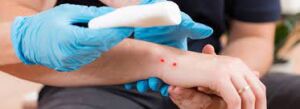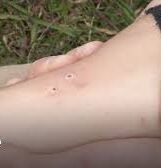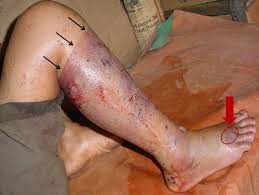Snake Bite Treatment: Immediate Care and Safety Tips
Snake bites are a serious health problem in many parts of the world and occurs when a person is bitten by a snake. It’s a potentially dangerous situation, especially if the snake is venomous. Venomous snakes inject venom into their prey through specialized fangs, which can cause a range of symptoms and complications in humans. These symptoms can vary widely depending on factors such as the type of snake, the amount of venom injected, and the location of the bite on the body. Symptoms can range from minor local tissue damage to major systemic effects such as organ failure and paralysis. Treatment may include antivenom and supportive care; however, prevention is the best means of avoiding this condition. Education regarding proper snake handling techniques and avoidance measures should be taken into consideration when living or working in areas populated by venomous reptiles. Please keep reading for details on the following topics:
Effects of snake venom
Symptoms of snake bite
Management of a snake bite
Prevention of snake bites

EFFECTS OF THE VENOM FROM A SNAKE
The effects of snake venom can vary depending on the species of snake and the composition of its venom. However, there are several common effects that venomous snake bites can cause:
- Swelling: Venom can lead to significant swelling in the area of the bite, which may spread to nearby tissues.
- Tissue and blood vessel damage: Venom can cause damage to tissues and blood vessels near the bite site, leading to local tissue destruction and potentially severe bleeding.
- Inhibition of blood clotting: Some snake venoms contain toxins that interfere with the body’s ability to form blood clots, leading to abnormal bleeding and difficulty in stopping bleeding from the bite wound.
- Paralysis: Certain snake venoms can affect the nervous system, leading to paralysis of muscles in the affected area or throughout the body.
- Infection of the blood: Bites from some snakes can introduce bacteria into the bloodstream, leading to potentially life-threatening infections.
- Muscle breakdown: In some cases, snake venom can cause muscle breakdown (rhabdomyolysis), leading to the release of harmful substances into the bloodstream and potentially resulting in kidney damage.
These effects can vary in severity depending on factors such as the amount of venom injected, the location of the bite, the size and health of the victim, and the time it takes to receive medical treatment. Prompt medical attention is essential in cases of snake bites to minimize the impact of venom and prevent serious complications.
SYMPTOMS OF A SNAKE BITE

Symptoms of a snake bite can vary depending on factors such as the type of snake, the amount of venom injected, and the individual’s reaction to the venom. However, common symptoms may include:
- Pain: Immediate pain at the site of the bite is a common symptom. The pain may range from mild to severe, depending on the severity of the bite.
- Swelling and redness: Swelling and redness around the bite area are typical early signs of a snake bite. The swelling may spread rapidly and affect nearby tissues.
- Tissue damage: Snake venom can cause tissue destruction at the site of the bite, leading to blistering, bruising, and in severe cases, tissue necrosis (death of tissue).
- Abnormal blood clotting: Some snake venoms contain toxins that interfere with the body’s ability to form blood clots, leading to abnormal bleeding from the bite wound or other areas of the body.
- Systemic symptoms: Snake bites can lead to systemic symptoms affecting various organ systems, including:
- Nausea and vomiting
- Weakness and fatigue
- Headache
- Dizziness and fainting
- Difficulty breathing
- Rapid heart rate
- Low blood pressure
- Pale or clammy skin
-
Neurological symptoms: In cases of envenomation by neurotoxic snakes, symptoms may include:
- Numbness or tingling around the face or extremities
- Paralysis, starting from the site of the bite and spreading to other parts of the body
- Difficulty speaking or swallowing
- Vision disturbances
THINGS TO AVOID DOING WHEN MANAGING A SNAKE BITE
When managing a snake bite, it’s crucial to avoid certain actions that could worsen the situation or cause further harm. Here are things to avoid doing:
- Picking up the snake or attempting to kill it: Provoking the snake increases the risk of getting bitten again, potentially causing more harm.
- Applying a tourniquet: Tying a tourniquet above the bite site can restrict blood flow to the affected limb, leading to tissue damage and worsening the effects of the venom.
- Cutting into the wound: Attempting to cut or incise the bite area can increase the risk of infection and may not effectively remove venom.
- Attempting to suck out the venom: This method is ineffective and can introduce bacteria into the wound, increasing the risk of infection. It may also lead to the person ingesting venom, which can be harmful.
- Applying ice or submerging the wound in water: Cold compresses or submerging the wound in water can worsen tissue damage and increase pain.
- Consuming alcohol or caffeine: Alcohol and caffeinated beverages can exacerbate symptoms and interfere with medical treatment. They may also mask the severity of symptoms, leading to delayed medical care.
-
Taking pain-relieving medication without medical advice: Certain pain medications can interfere with blood clotting and exacerbate the effects of venom. It’s essential to consult a healthcare professional before taking any medication.
PREVENTION OF SNAKE BITES
Preventing snake bites is essential for reducing the risk of encountering venomous snakes and avoiding potentially harmful situations. Here are some preventive measures:
- Awareness and Education: Learn about the types of snakes in your area and their habitats. Educate yourself and others about snake behavior, common hiding spots, and how to safely coexist with snakes.
- Wear Protective Clothing: When venturing into areas where snakes may be present, wear long pants, high-top leather boots, and thick socks to minimize exposure to snake bites.
- Watch Your Step: Be cautious when walking in tall grass, rocky areas, or dense vegetation where snakes may hide. Watch where you step and avoid placing your hands or feet in areas where you cannot see clearly.
- Use Tools: When working outdoors, use a long stick or tool to probe areas where snakes may be hiding, such as woodpiles, rock crevices, or brush piles.
- Keep a Safe Distance: If you encounter a snake, give it space and back away slowly. Do not attempt to capture, handle, or provoke the snake, as this increases the risk of getting bitten.
- Secure Living Spaces: Seal off entry points to your home, such as gaps under doors, cracks in walls, or holes in screens, to prevent snakes from entering indoor spaces.
- Maintain a Clean Environment: Keep your yard and surroundings clean and free of debris, clutter, and potential hiding spots for snakes. Trim vegetation, remove piles of wood or debris, and keep grass trimmed short.
- Use Snake Repellents: Consider using snake repellents or deterrents around your property, such as chemical repellents or sonic devices, to discourage snakes from entering your property.
- Be Vigilant in Nature: When hiking, camping, or participating in outdoor activities, be vigilant and watch for signs of snakes. Stay on designated trails, avoid wandering into dense vegetation, and be cautious around rocks, logs, and other potential hiding spots.
-
Seek Professional Help: If you have a snake infestation or encounter a snake in your home or property, contact a professional pest control or wildlife removal service to safely remove the snake.
MANAGEMENT AND TREATMENT OF SNAKE BITES

Effective management and treatment of snake bites are crucial for minimizing complications and promoting recovery. Here are the steps involved:
- Seek Immediate Medical Attention: If bitten by a snake, seek medical help immediately, even if the bite appears to be from a non-venomous snake. Call emergency services or go to the nearest hospital as soon as possible.
- Stay Calm and Immobilize the Affected Limb: Keep the bitten person as calm and still as possible to slow the spread of venom. Immobilize the affected limb and keep it elevated slightly below heart level to reduce swelling and slow the spread of venom. When someone is bitten by a snake, it’s crucial to immobilize the affected limb as much as possible. Limiting movement helps slow the spread of venom throughout the body, reducing the severity of symptoms and complications. Here’s why limiting movement is important:
- Slows Venom Spread: Restricting movement helps prevent the venom from spreading rapidly through the lymphatic system and bloodstream. This can buy time for medical treatment to be administered.
- Minimizes Tissue Damage: Movement can exacerbate tissue damage at the bite site and surrounding areas. Immobilizing the limb reduces the risk of further injury and tissue destruction.
- Reduces Pain: Limiting movement can help alleviate pain and discomfort associated with the snake bite. It can also prevent additional trauma to the affected area, which could worsen pain.
- Prevents Venom Redistribution: Movement can cause venom that has already been absorbed into the bloodstream to redistribute to other parts of the body more quickly. Immobilization helps contain the venom at the bite site.
To limit movement effectively, the following steps can be taken:
- Encourage the bitten person to remain still and avoid unnecessary movement.
- Immobilize the affected limb by splinting it with a rigid object, such as a stick or board, to prevent bending or flexing.
- Keep the limb elevated slightly above heart level to reduce swelling and slow the spread of venom.
- Avoid massaging or manipulating the bite area, as this can increase venom absorption and tissue damage.
- Identify the Snake if Possible: If safe to do so, try to identify the snake or remember its color, size, and markings. This information can help healthcare providers determine the appropriate treatment, such as administering antivenom.
- Clean the Bite Area: Wash the bite area with soap and water to help reduce the risk of infection. Avoid using alcohol or antiseptics that can damage tissues.
- Do Not Attempt Home Remedies: Avoid applying tourniquets, ice packs, or attempting to suck out venom, as these methods are ineffective and can worsen the situation. Applying a tourniquet is generally not recommended for snake bites. Tourniquets restrict blood flow to the affected limb, which can exacerbate tissue damage and increase the risk of complications. However, in some rare cases where a highly venomous snake has bitten a person and medical help is not immediately available, a tourniquet may be considered as a last resort. This is typically only done if the snake bite is on a limb and if the individual is far from medical assistance, such as in a wilderness setting.If a tourniquet is applied, it should be done with caution and only by someone trained in wilderness first aid or emergency medical procedures. The tourniquet should be placed several inches above the bite site, tight enough to stop blood flow to the limb, but not so tight as to cause further tissue damage or pain. It’s important to clearly mark the time the tourniquet was applied and to loosen it periodically to allow some blood flow to the limb. However, this should only be done if absolutely necessary and under the guidance of medical professionals.
- Remove Jewelry and Tight Clothing: Remove any rings, bracelets, or tight clothing near the bite site to prevent constriction as swelling occurs.
- Transport to Medical Facility: Transport the bitten person to the nearest medical facility as quickly and safely as possible. Do not delay seeking medical attention.
- Treatment in the Emergency Room: Once at the hospital, healthcare providers will assess the severity of the snake bite and administer appropriate treatment. Treatment may include:
- Administration of antivenom: Antivenom is the most effective treatment for snake bites and works by neutralizing the venom in the body.
- Pain management: Pain medication may be given to alleviate discomfort associated with the bite.
- Antibiotics: Antibiotics may be prescribed to prevent or treat infection.
- Intravenous fluids: Fluids may be given to maintain hydration and support blood pressure.
- Tetanus vaccination: A tetanus shot may be administered if the person’s tetanus vaccination status is not up to date.
- Monitoring and Observation: Bitten individuals may be monitored in the hospital for several hours to ensure that symptoms do not worsen and that the antivenom is effective. Additional doses of antivenom or other treatments may be given as needed.
- Follow-Up Care: After initial treatment, follow any instructions provided by healthcare providers for wound care, medication, and follow-up appointments. Attend all scheduled follow-up appointments to monitor recovery progress and address any complications.
WHAT HAPPENS ON ARRIVAL TO THE EMERGENCY ROOM
When a person arrives at the emergency room after a snake bite, they will undergo a series of assessments and receive medical treatment tailored to their condition. Here’s what typically happens upon arrival to the emergency room:
- Initial Assessment: The medical staff will conduct an initial assessment to evaluate the severity of the snake bite and the person’s overall condition. This may involve checking vital signs such as heart rate, blood pressure, and respiratory rate.
- History Taking: The medical team will ask about the circumstances surrounding the snake bite, including the type of snake, the time of the bite, and any initial first aid measures taken.
- Physical Examination: A thorough physical examination will be performed to assess the bite wound and any signs of envenomation or systemic effects. The medical staff will also check for signs of allergic reactions or other medical conditions that may complicate treatment.
- Diagnostic Tests: Depending on the severity of the snake bite and the presenting symptoms, various diagnostic tests may be ordered. These may include blood tests, imaging studies (such as X-rays or ultrasound), and coagulation studies to assess blood clotting function.
- Treatment Initiation: Based on the assessment findings, appropriate treatment will be initiated. This may include:
- Administration of antivenom: If the snake bite is from a venomous species and signs of envenomation are present, antivenom will be administered to neutralize the venom.
- Pain management: Medications such as analgesics or opioids may be given to alleviate pain associated with the snake bite.
- Antibiotics: If there is evidence of infection or risk of infection, antibiotics may be prescribed to prevent or treat bacterial complications.
- Antihemolytic medication: This medication helps prevent the breakdown of red blood cells, which can occur as a result of certain snake venoms.
- Tetanus shot: A tetanus vaccination may be given if the individual’s vaccination status is not up to date. Tetanus can be a risk with puncture wounds like those caused by snake bites.
- Blood transfusion: In severe cases where there is significant blood loss or clotting abnormalities, a blood transfusion may be necessary.
- Supportive care: Intravenous fluids may be given to maintain hydration and support blood pressure. Additional supportive measures may be provided as needed.
- Monitoring: The person will be closely monitored for signs of complications or adverse reactions to treatment. This may include continuous monitoring of vital signs including temperature, respiratory rate, pulse, and blood pressure, neurological status, and laboratory parameters.
- Observation and Hospitalization: Depending on the severity of the snake bite and the response to treatment, the person may be admitted to the hospital for further observation and management. Hospitalization allows for ongoing monitoring and adjustment of treatment as needed. Antivenom can sometimes cause allergic reactions or other side effects, so close monitoring is necessary.
- Wound assessment and dressing: The wound will be assessed to check for the presence of dirt, broken fangs, or other debris. A clean, dry dressing will be applied to the wound to prevent infection and promote healing.
- Surgery for complications: In cases where complications such as compartment syndrome arise, surgical intervention may be necessary to alleviate pressure and save the affected limb.
- Follow-Up Care: After initial treatment, the person will receive instructions for wound care, medication management, and follow-up appointments. It’s important to adhere to these instructions to ensure proper healing and recovery.
Disclaimer: The information provided in this content is for general informational purposes only. It is not intended as medical or healthcare advice, diagnosis, or treatment. Always seek the advice of a qualified healthcare professional with any questions you may have regarding a medical condition or healthcare decisions.

